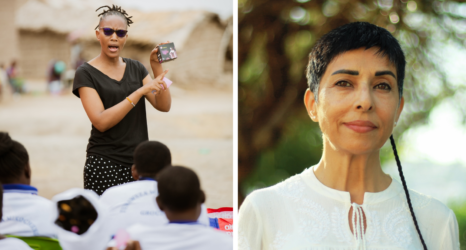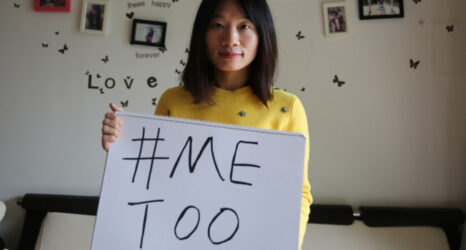Feminist journalism is essential to public discourse. It is essential to political debate. And it absolutely essential to free and fair democracy. Explore more at Feminist Journalism is Essential to Democracy—Ms. magazine’s latest installment of Women & Democracy, presented in partnership with the International Women’s Media Foundation.
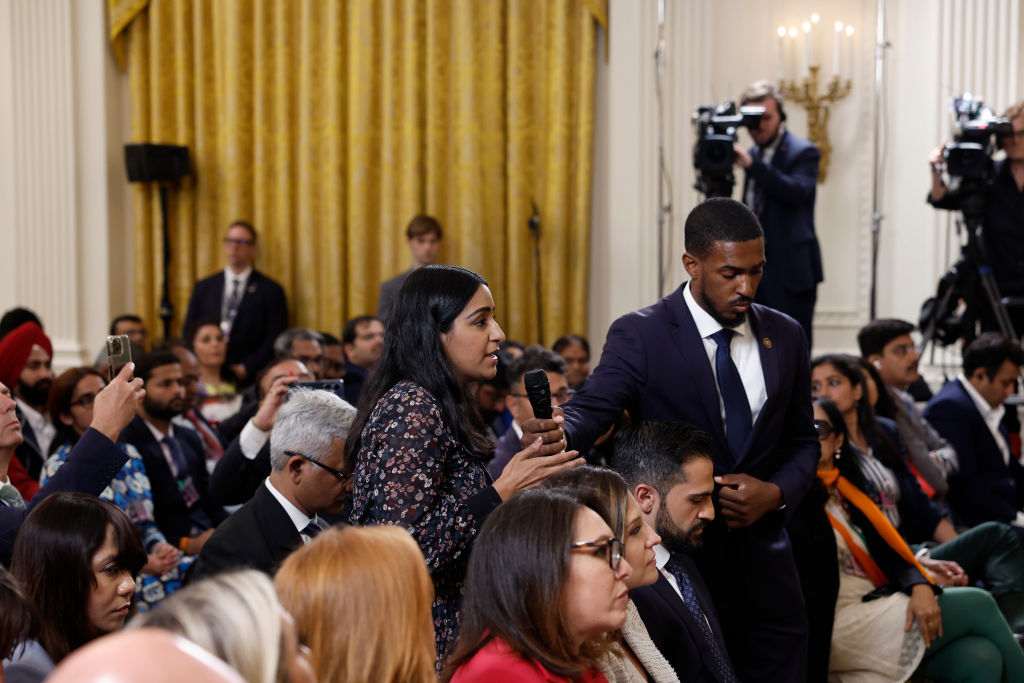
The international recognition of the IWMF’s Courage in Journalism Awards gives women and nonbinary reporters a “mantle of safety and security,” said Elisa Lees Muñoz, executive director of IWMF.
Since taking office in 2014, Muslims in India have faced rampant violent discrimination—including death—for doing things such as: eating beef, giving their child a Muslim name, protesting and wearing hijabs. On June 22, 2023, during a press conference with the prime minister of India, Narendra Modi, and President Joe Biden, Wall Street Journal reporter Sabrina Siddiqui posed a question to Modi asking him to discuss the accusations of discrimination of religious minorities against his government.
Siddiqui asked, “What steps are you and your government willing to take to improve the rights of Muslims and other minorities in your country and to uphold free speech?”
Despite previous campaigns to block Modi from entering the U.S., Modi appeared shocked by Siddiqui’s question.
Amit Malviya—the head of the Bharatiya Janata Party (BJP), the ruling political party in India under Modi—took to Twitter to enrage his followers, tweeting that Modi “completely destroyed the motivated question on steps being taken to ‘protect’ rights of Muslims and other minorities” and that this “was another blow to the toolkit gang,” an insult used by leaders in the BJP to dismiss critics of Modi. His tweet started the storm of attacks launched against Siddiqui in response to her question.
Siddiqui soon became the target of a strategic and violent online campaign. Siddiqui’s attackers—many aligned with the BJP—attacked her religious beliefs, heritage and gender; many claimed she was a “Pakistani extremist.”
Many news organizations are not equipped to deal with this sort of harassment, mainly because most news organizations are headed by men that don’t experience this sort of violence.
Elisa Lees Muñoz, executive director of IWMF
The attacks against Siddiqui were so rampant that various organizations, including the White House and the International Women’s Media Foundation (IWMF), organized campaigns of public support and condemned their attackers for violating the basic tenets of the free press.
For Women Journalists, Harassment Is Commonplace
This sort of coordinated online attack against women journalists is a daily occurrence. Nearly one-third of women journalists consider leaving the profession due to online attacks and threats. A survey conducted by the IWMF in 2018 found:
- 12 percent of women journalists said they had their phone tapped.
- 10 percent reported receiving death threats, fake social media accounts made under their names, had physical threats sent to their private phone number, had emails hacked and have been doxed, just in that year.
- 90 percent said there has been a significant increase in online harassment over the past five years.
“It is the stuff of everyday for women, trans and LGBTQI+ journalists to face an onslaught of violence, threats, et cetera. That has become a journalist’s day-to-day,” Elisa Lees Muñoz, executive director of the IWMF, told Ms. “This sort of violence is commonplace. Many news organizations are not equipped to deal with this sort of harassment, mainly because most news organizations are headed by men that don’t experience this sort of violence.”
Lees Muñoz said there is a “safety barrier” that prevents women journalists from being able to do this work. “You cannot do your work if you’re not safe. When we see women journalists targeted, we have to do something to stop that.”
Seventy-eight percent of U.S.-based women journalists and 68 percent of women journalists abroad said their gender significantly contributed to the harassment they faced.
A journalist interviewed for this research who chose to go by the alias Carrie noted that after receiving a nearly constant onslaught of online harassment and bullying, including veiled death threats and sexually suggestive photos, she was “feeling pretty depressed. I felt really alone,” and that she “didn’t want to write things that would bring on the attacks again.”
Another journalist who worked for a Southern daily newspaper who used the alias Ada stated that at least once a month she was called a “n****r b***h” during her 11-year tenure at the paper. The last email that made her finally leave her job came with a terrifying racialized threat. It read, “You really are a n****r b***h. I will r**e you and throw you in the gutter.”
When Ada brought these emails to the newspaper managers, she was made to feel as though she was overreacting. When she finally quit, they treated her as if she was the problem, stating that she was choosing not to ignore the harassment. Ada left because despite receiving constant harassment and threats, no one in a position of power at her job took her seriously—an unfortunate reality for many women who come forward with stories of harassment.
A UNESCO study from 2021, “The Chilling: Global Trends in Online Violence Against Women Journalists,” found that women who spoke up and told employers about the harassment they faced were often dismissed, and when they brought the threats to law enforcement, they were often told to simply “log off.” In an increasingly online world, journalists have come to rely on social media for work, and it can be challenging to do their job without an active social media presence.
Studies show that the psychological impact can be long-standing, so logging off isn’t a fix-all solution either, whether attacks are physical or virtual. Over half the women who had been harassed, threatened or assaulted experienced long-term post-traumatic stress-related symptoms. such as having strong physical reactions when something reminded them of the event, feeling negative about themselves or having trouble sleeping.
When the International Women’s Media Foundation began in 1990, the organization wanted to ensure the safety of women journalists, whether they were field-reporting or sitting in an office. Their first task was to acknowledge the layers of marginalization that fuel harassment and violence of journalists. The IWMF recognizes that women, nonbinary people, trans people, the LGBTQI+ community and people of color face disproportionate harassment when compared to their cis male coworkers.
The IWMF provides skills workshops, anti-harassment training and financial resources for women in journalism. They strive to support stories that male-run news conglomerates don’t want to be told, therefore ensuring that diverse voices have a chance to be heard. They also provide emergency funding for journalists who are experiencing extreme hardship or harassment.
As online harassment became more prevalent over the years, the IWMF has created the Coalition Against Online Violence, with over 70 organizations working to combat online attacks.
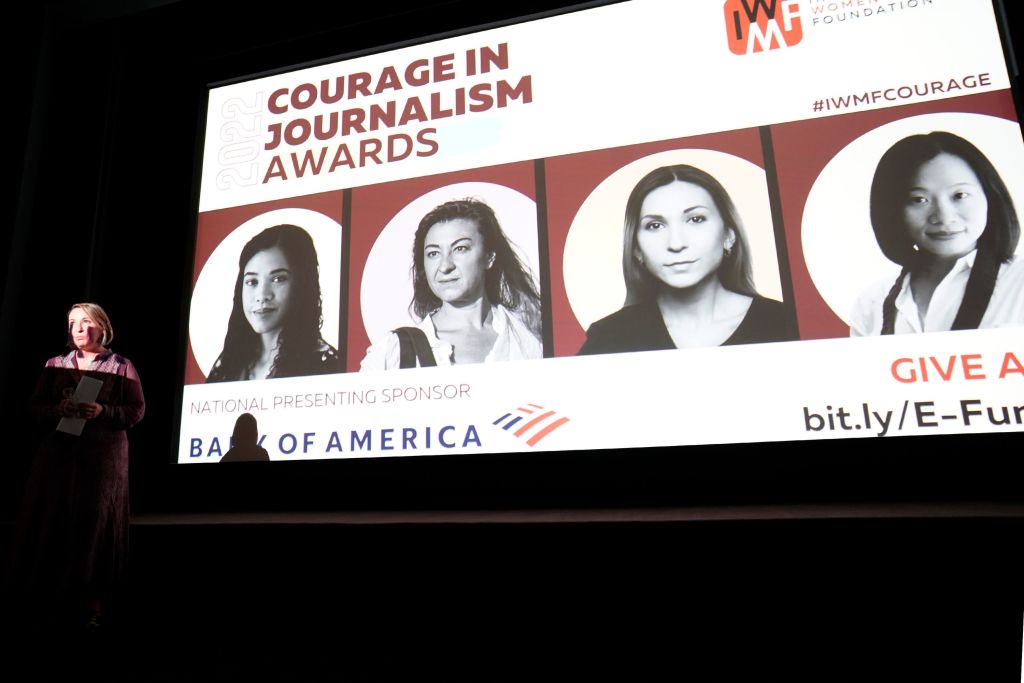
The IWMF also coordinates the Courage in Journalism awards—which they created to recognize women journalists who risk their lives everyday to cover stories that need to be shared. The international recognition provides these courageous women with a “mantle of safety and security,” said Lees Muñoz. Winning the award means they are internationally recognized and more likely to be protected if something goes wrong.
Lees Muñoz said the winners each year are “blown away by the fact that someone knows about their work, and it is a huge boost to be recognized and helps them to keep going in their struggle.”
In 2018, the IWMF chose to add a subcategory to the Courage in Journalism award: the Wallis Annenberg Justice for Women Journalists Award, given to women journalists imprisoned for their work. Lees Muñoz said that with this award, the IWMF “wanted to highlight the cases of women who have been imprisoned. The stories of incarcerated journalists languish in prison unless there is an update on their cases. We want to ensure we always have these women at the top of our minds, no matter how long they’ve spent in prison.”
Ms. and the IWMF Feature Voices of Decorated Women Journalists at Risk
Over the next several months, Ms. and the IWMF will collaborate to highlight the works of these journalists, all of whom are nominees or winners of the Courage in Journalism award. We will talk with this year’s winners, including the Women of The Washington Post Reporting on Ukraine, some of whom came under heavy artillery fire; and Maria Teresa Montaño Delgado, a freelance journalist and director of the investigative portal The Observer, whose work focuses on the corruption in the state of Mexico. Her reporting led to harassment from high ranking political officials and threats to her family.
We will also be taking a look back at previous winners, including Cerise Castle, who won the Courage in Journalism Award in 2022 for her work on the Deputy Gangs of Los Angeles and uncovered 19 murders committed by the LA County sheriff’s department.
Another winner, Moscow-based reporter Anna Nemtsova, is considered one of the most outspoken reporters in the region, which has led to daily threats, slander and physical harassment.
In the early days of the internet, when the IWMF started, there was hope that connecting people across the globe would create a unifying call and that the world wide web would act as the “great equalizer.” In an increasingly globalized news market, women journalists have learned that social media and other online forms of communication have meant that the harassment they face is unending; the internet often gives a platform for the most hateful people to coalesce and target marginalized groups.
Last year, 12 women journalists were murdered, and the number of women journalists imprisoned rose by 64 percent. By continuing to award courageous journalists, the IWMF is making it known that the threat of violence against women reporters is ever-present. Still, it also is a testament to the unwavering spirit of women journalists globally.
The IWMF relies on donations to keep fighting for women journalists. You can donate here.
If you want to attend this year’s award reception gala in DC, NYC or LA, you can learn more here.
Care about uplifting women‘s voices? We do too. Let Ms. keep you up to date with our daily + weekly newsletters. (Or go back to the essay collection.)
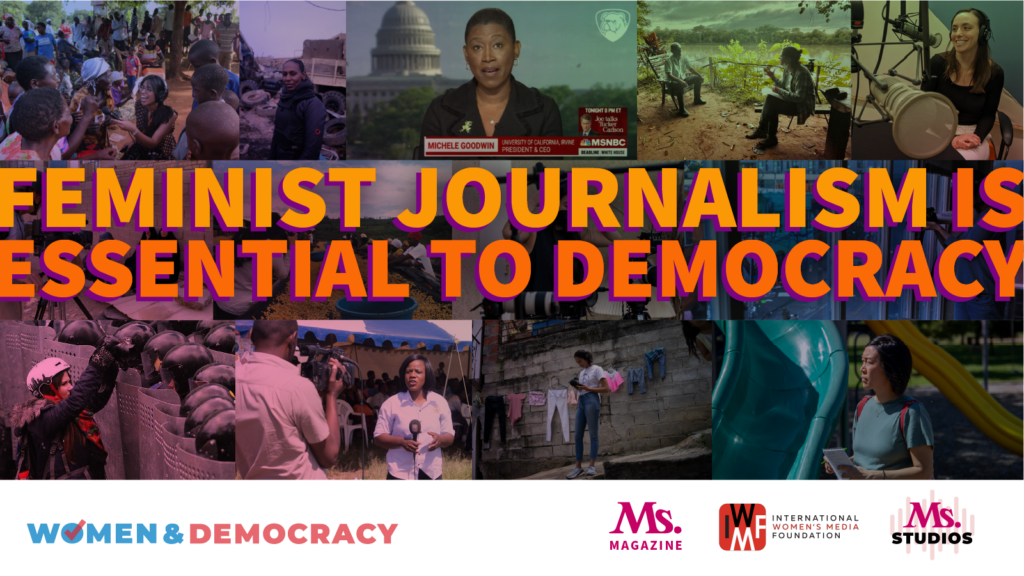
Up next:
U.S. democracy is at a dangerous inflection point—from the demise of abortion rights, to a lack of pay equity and parental leave, to skyrocketing maternal mortality, and attacks on trans health. Left unchecked, these crises will lead to wider gaps in political participation and representation. For 50 years, Ms. has been forging feminist journalism—reporting, rebelling and truth-telling from the front-lines, championing the Equal Rights Amendment, and centering the stories of those most impacted. With all that’s at stake for equality, we are redoubling our commitment for the next 50 years. In turn, we need your help, Support Ms. today with a donation—any amount that is meaningful to you. For as little as $5 each month, you’ll receive the print magazine along with our e-newsletters, action alerts, and invitations to Ms. Studios events and podcasts. We are grateful for your loyalty and ferocity.





